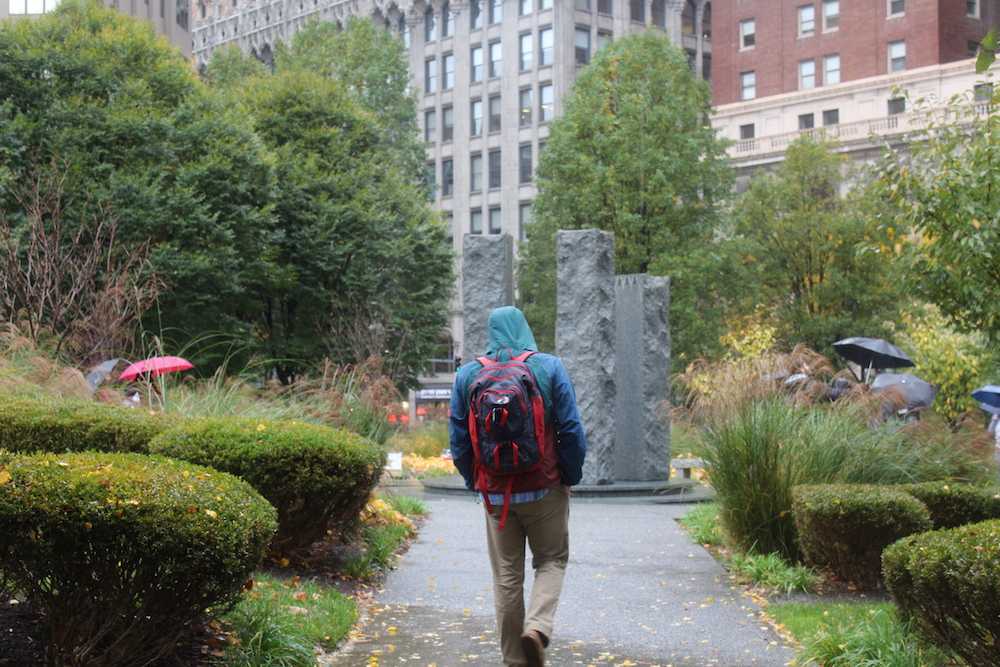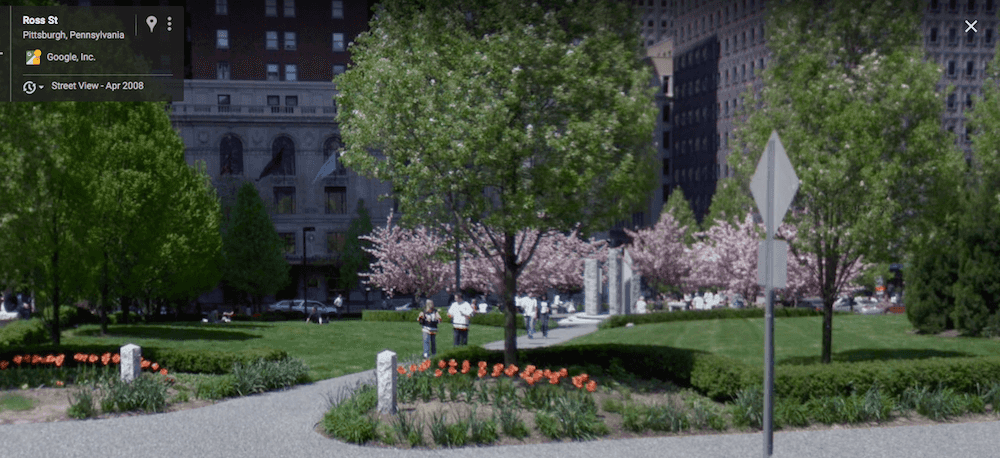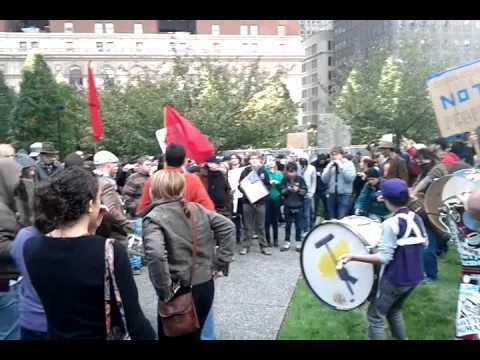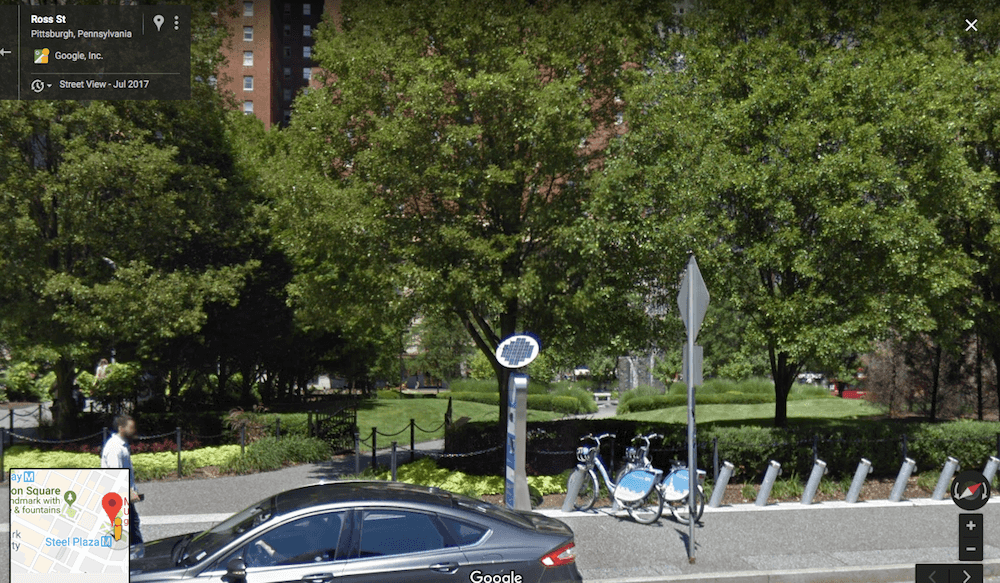Secret Pittsburgh
Mellon Green: How A Space Changed Through Time
By Blair Drake
If time is the dimension of change, then space is the dimension of coexisting difference. And that is both a source of nourishment . . . And a challenge.” - Doreen Massey
Mellon Green is a small greenspace in downtown Pittsburgh. Owned by BNY Mellon, it has changed significantly over the last eight years, in both appearance and use. As a Pittsburgh native, I have seen the progression of the space firsthand. It has gone from a flat, open, inviting space to a curated, gated, intimidating one. This dramatic change came after the Occupy Pittsburgh movement took place mainly in Mellon Green. This protest, against neoliberism, angered the company BNY Mellon, who owned this public space. While there was contention over the use of a privately-owned public space, BNY eventually got a court-order to evict the protestors. Once the movement was removed, BNY decided to change the space, making it harder for mass groups of people to congregate there, and gating it to keep people out during certain hours and seasons. Now, this space is mostly used by business men and women during their breaks.
Mellon Green Before Occupy Pittsburgh:
Before the protestors took Mellon Green as their space, the area was quaint and open. The land was flat and vast, with four sidewalks running through them towards the center where the fountain stands. There were minimal trees and plants throughout the landscape, allowing for people to use the lawn. As seen in the first picture above, it was possible to see the majority of the space from the street. You can see people lounging in the lawn, hanging around the fountain, and enjoying the greenspace. As a child, I remember having picnics in this area, with one of my parents, while the other worked. It was nice to have the space where we could enjoy nature inside of the city. I saw people from all walks of life using the space, from the well-dressed business men and women, to families playing games in the lawn with shorts and t-shirts on. It was a space for anyone who wanted to use it, and it was beautiful. Though it was a public space that was privately owned, BNY Mellon did not show an interest in the people who used the space. As long as the space was not damaged, or littered, all were happy. This changed on October 15, 2011.
Mellon Green During Occupy Pittsburgh:
The Occupy movement came to Pittsburgh during the fall of 2011. Mellon Green was turned into a meeting place for the protestors, and many even made it their living space. The second picture shows the protestors moving into the space and claiming it for their cause. This movement was sparked by the financial crisis of 2008, and the global events that happened through 2011. Occupy’s motive was to take the power away from corporations and large companies and give it to the working class. The movement also spoke against war and for the environment. While Occupy was meant to be leaderless, this often did not work out (Sarah). In Pittsburgh, the movement became a sensation in the news (https://pittsburgh.cbslocal.com/tag/occupy-pittsburgh/ ). This led many Pittsburghers to develop a strong opinion about the movement, which were polarized. While many thought the protestors to be freedom fighters, and that they had every right to use the Mellon Green as their home base, just as many, if not more, saw them as a disgrace to the city. For me, I was fifteen years old and I did not know much of the movement. I remember passing Mellon Green with my mom and asking why so many people were living in tents there. I, like many, thought they were homeless until I learned more about the protestors. The contention between the protestors and BNY Mellon grew as time went on, and this eventually led to the eviction of the movement.
Eviction of Occupy Pittsburgh and Remodeling of Mellon Green:
While the official standing of Mellon Green was that it was a public plaza, and BNY Mellon had stewardship, BNY obtained a court order to evict the protestors (Sarah). While many thought the eviction would be violent and chaotic, like the eviction of Occupy Wall Street, it was quiet and calm. Many of the protestors slowly moved out and gave the space up (Article). On February 8, 2012, Occupy Pittsburgh was officially over. The aftermath of the movement was solely focused on Mellon Green. While the lawn was in a rough condition, due to the tents and people being there during the winter months, BNY Mellon sought to fix the space with more restrictions. The space was closed for remodeling, which disappointed many. Among the renovations was the gates ( https://pittsburgh.cbslocal.com/2012/06/27/mellon-green-park-to-reopen-with-a-gate/).
Mellon Green Today:
Today, Mellon Green is very different from what it once was. The landscape is no longer flat or open. The only area that people now use is the four sidewalks and center area with the fountain. The third picture shows Mellon Green in 2017 from the same view as the first picture. The addition of more trees and shrubbery makes the space seem less accessible and friendly. The fountain is mostly hidden, and there is barely anyone in the space, even though it is the summer. A chain surrounds the space, so that people do not enter when unwanted, and there is a gate at each entrance. This gate is closed from dusk to dawn, and the majority of the winter. While Mellon Green was open at all time before, this is no longer the case. BNY Mellon restricts when the space is open, and what activities can occur in the space. A sign sits each entrance, which tells patrons when the space is closed and that a full list of rules can be found at the security desk inside BNY Mellon Center. This indicates that there are major restrictions on what is allowed to happen inside the space, and that patrons must go out of their way to find these rules out. Also, the demographics that use the space has narrowed. Now, Mellon Green is mostly used by business men and women, and the few who enjoy sitting by the fountain. I currently still use the space, but instead of having a picnic in the lawn, my activities are limited to reading a book on one of the benches by the fountain. The majority of people I see in the space are just using the sidewalks to get from one part of downtown to another, instead of walking around the whole space, like the fourth picture shows. Very rarely do I see people using the space as it once was used, and I have yet to see any families spend more than ten minutes here. While Mellon Green is still a “public greenspace”, the function of the space has forever changed.
Works Cited:
Hakimzadeh, Sarah. "Mellon Green and Occupy Pittsburgh." Secrets of Pittsburgh, 9 November 2018, Cathedral of Learning, Pittsburgh, PA. Lecture.
Williamson, Alicia. "The space of occupation." Critical Quarterly, vol. 54, no. 2, pp. 69-71.



